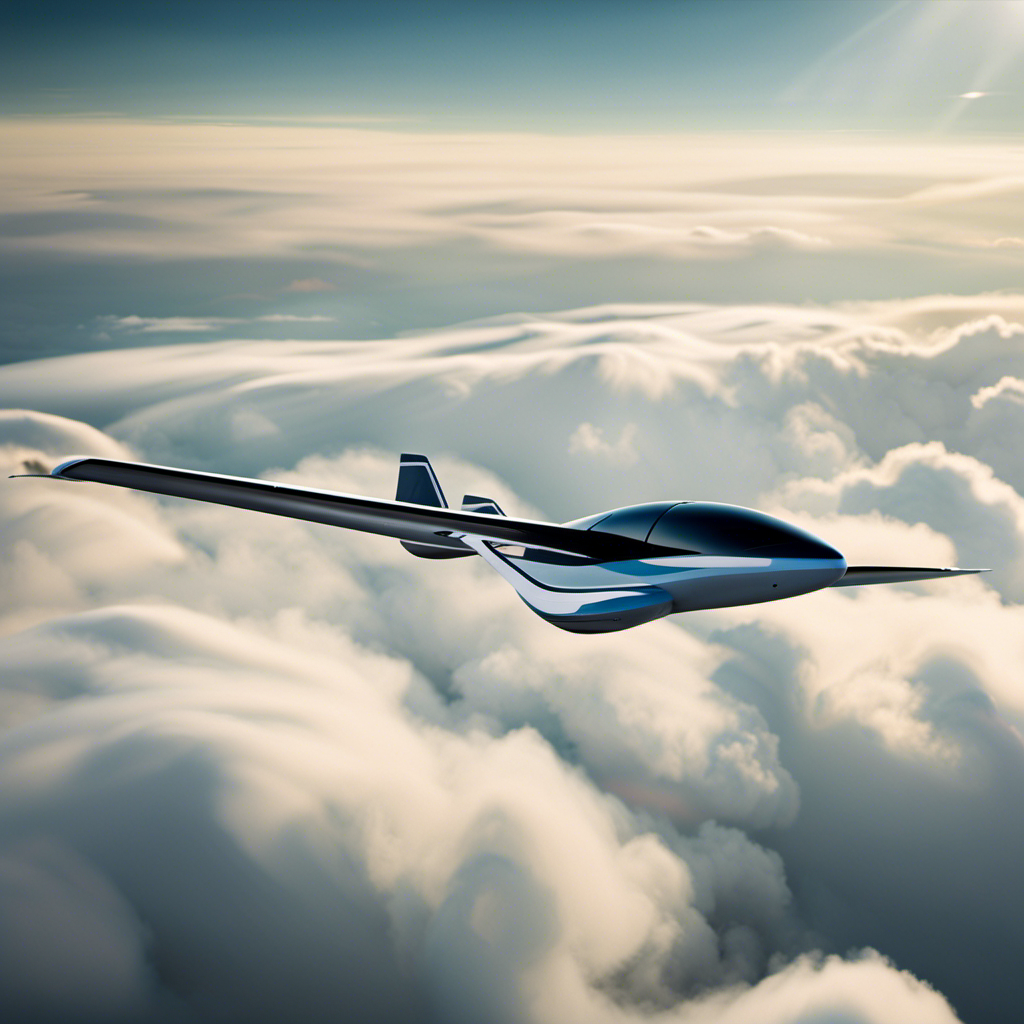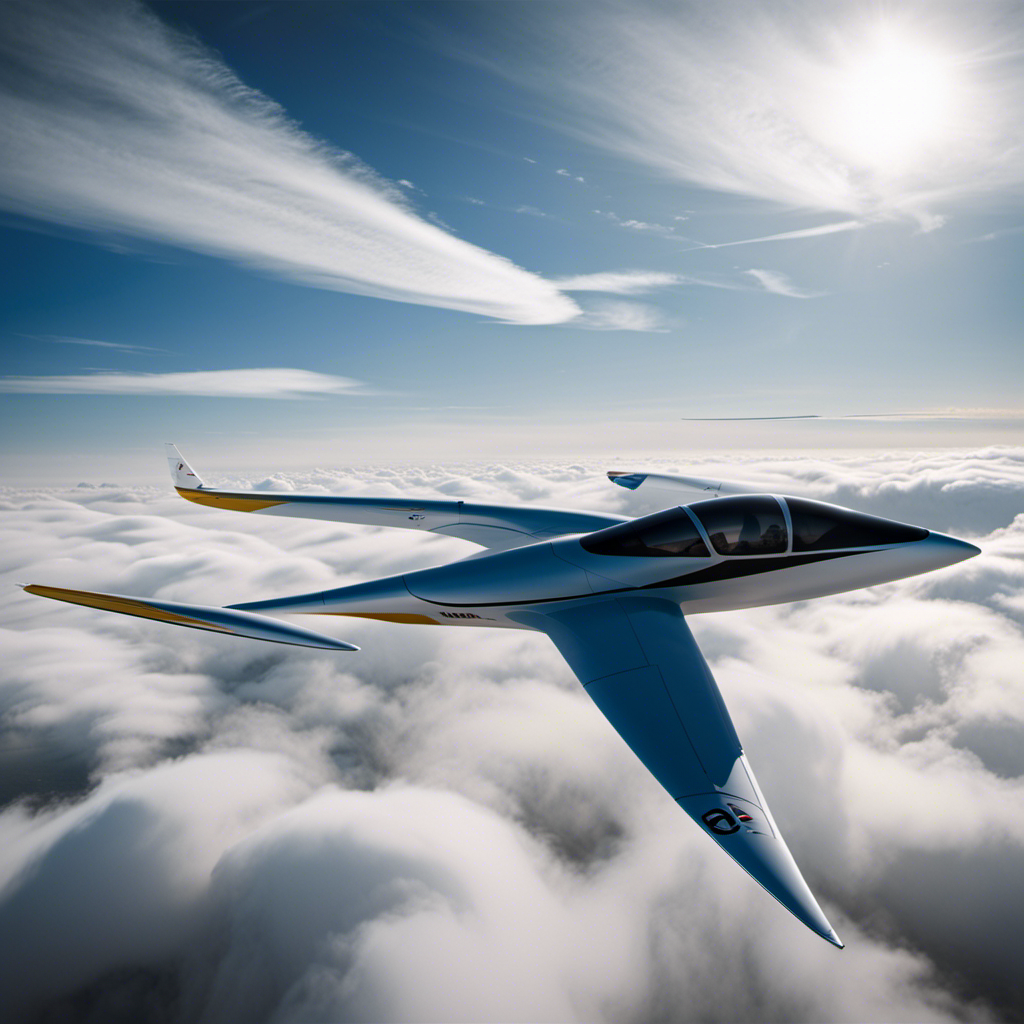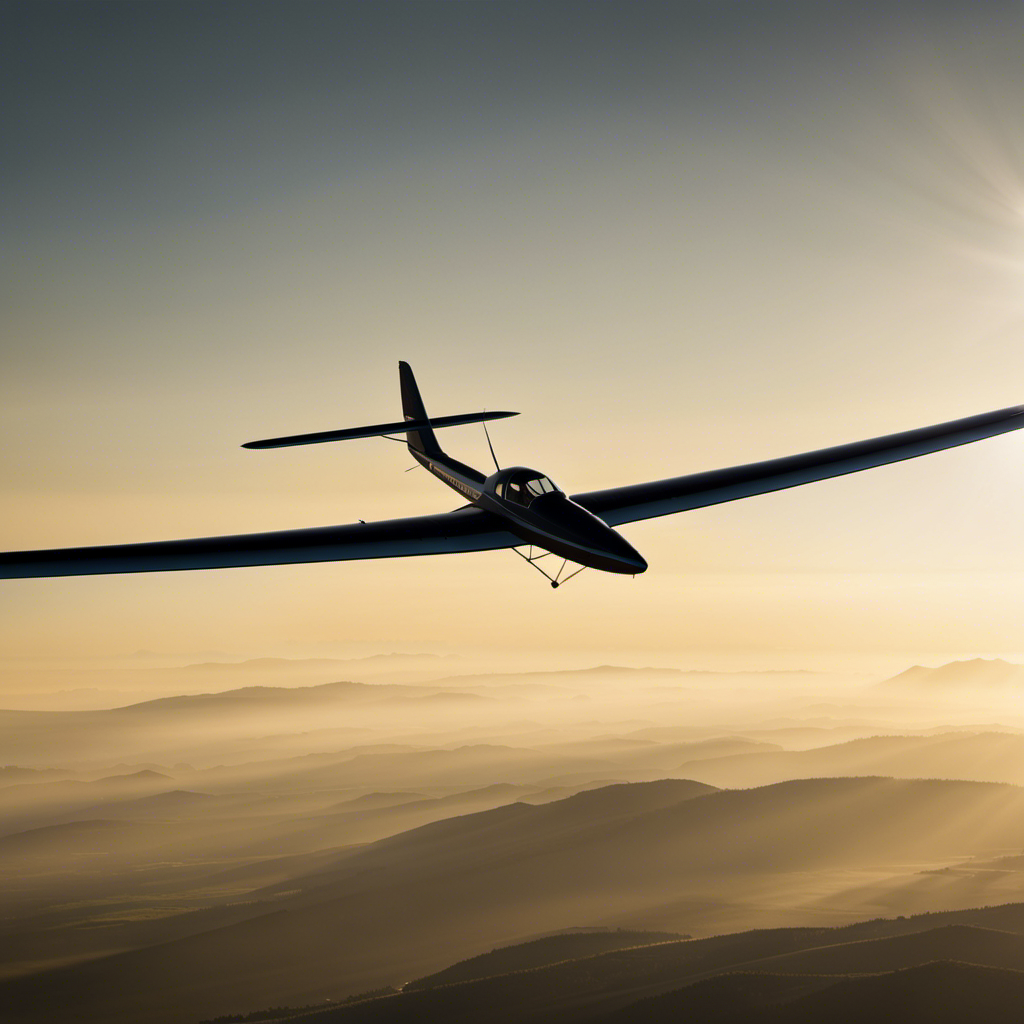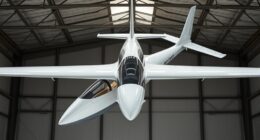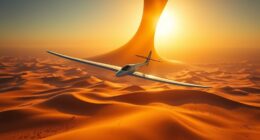As a pilot, I have always been captivated by the freedom and grace of flying through the skies.
But what if you could take that experience to new heights?
In this guide, we’ll explore the world of gliders with engines, examining the pros and cons of this aviation marvel.
From enhanced flexibility in flight to increased takeoff and landing options, we’ll delve into the technical and analytical aspects of this soaring adventure.
So fasten your seatbelts and get ready for an exhilarating journey through the skies!
Key Takeaways
- Engine-powered gliders have higher costs of ownership due to fuel expenses, maintenance costs, specialized technicians, and higher insurance premiums.
- Proper licensing and training are required for engine-powered glider ownership, including certifications, training fees, exams, and ongoing currency requirements.
- Engine-powered gliders have limited availability in the market as manufacturers prioritize traditional gliders without engines.
- Engine-powered gliders may cause potential noise pollution and environmental impact through fuel consumption and carbon emissions, but sustainable alternatives like electric engines are being developed.
Enhanced Freedom and Flexibility in Flight
One of the main advantages of gliders with engines is the enhanced freedom and flexibility they offer in flight. These gliders are designed to have improved maneuverability, allowing pilots to navigate through different types of airspace more easily. The addition of an engine gives pilots the ability to adjust their speed and altitude as needed, providing greater control over the aircraft.
This increased flexibility is particularly beneficial in situations where weather conditions are unpredictable or when flying in congested areas. However, it is important to note that operating a glider with an engine does require a certain level of pilot skill and expertise. Pilots must be proficient in managing engine power, understanding fuel consumption, and coordinating engine use with traditional gliding techniques.
With these considerations in mind, the enhanced freedom and flexibility of gliders with engines can greatly enhance the overall flying experience. This improved control and adaptability seamlessly transitions into the subsequent section about increased takeoff and landing options.
Increased Takeoff and Landing Options
When considering gliders with engines, you’ll find that they provide you with increased takeoff and landing options. This is due to the fact that the engine allows for powered takeoffs, eliminating the need for a tow or a winch launch.
With the ability to take off under their own power, gliders with engines can also land in a wider range of locations, including smaller airstrips or even grassy fields. This takeoff and landing flexibility opens up a whole new world of possibilities for glider pilots, allowing them to explore areas that were previously inaccessible.
Additionally, the engine provides extended flight duration, as it can be used to sustain the glider’s altitude or to climb to higher altitudes, increasing the overall time spent in the air. This increased takeoff and landing flexibility, coupled with extended flight duration, makes gliders with engines a versatile and practical choice for pilots.
Moving on to the next section, let’s discuss their ability to fly in variable weather conditions.
Ability to Fly in Variable Weather Conditions
With the ability to fly in variable weather conditions, gliders with engines offer pilots increased flexibility and control. These gliders are designed to withstand adverse conditions, such as strong winds and turbulent weather, allowing pilots to safely navigate through challenging environments. This ability is crucial for pilots who rely on gliders for transportation or aerial work, as it ensures that they can operate in a wider range of weather conditions.
However, it is important to note that flying in adverse conditions can have an impact on fuel consumption. The engine in the glider needs to work harder to maintain stability and control, leading to increased fuel usage. Despite this, the ability to fly in adverse conditions greatly enhances the versatility and capabilities of gliders with engines.
Furthermore, the extended flight duration of gliders with engines is another significant advantage.
Extended Flight Duration
To maximize your flight time, you’ll be able to rely on the extended duration of gliders equipped with engines. These gliders offer an extended flight range due to their ability to carry fuel and operate the engine during flight.
This extended flight range allows pilots to explore new territories and stay airborne for longer periods of time. Additionally, gliders with engines are known for their fuel efficiency. The engines are designed to consume fuel in a much more efficient manner compared to traditional aircraft engines. This results in lower fuel consumption and reduced operating costs.
However, it’s important to note that there are some trade-offs when it comes to using engines in gliders. The added weight of the engine and fuel can affect the glide performance of the glider, making it slightly less efficient in soaring conditions.
Despite this, the extended flight duration and fuel efficiency offered by engines make them an attractive option for glider pilots.
Added Weight and Decreased Glide Performance
The added weight of the engine and fuel in gliders can affect their glide performance, making them slightly less efficient. When it comes to gliding, every ounce matters. Here are four key factors to consider regarding the impact of added weight on glide performance:
-
Decreased lift: The additional weight can reduce the ability of the glider to generate lift, resulting in a shorter glide distance.
-
Increased drag: The engine and fuel add extra drag, which can slow down the glider and reduce its glide ratio.
-
Altered balance: The added weight can shift the glider’s center of gravity, affecting its stability and handling characteristics during gliding.
-
Increased stall speed: The added weight can raise the stall speed of the glider, requiring a higher airspeed for safe gliding.
Considering these factors, it is evident that the added weight in gliders can have a negative impact on their glide performance. However, this is just one aspect to consider when evaluating the pros and cons of gliders with engines.
Moving on to the subsequent section, it is important to address the higher maintenance requirements associated with these aircraft.
Higher Maintenance Requirements
Considering the higher maintenance requirements, it’s crucial to factor in the added costs associated with owning and operating gliders equipped with engines. Maintaining an engine-powered glider involves regular inspections, oil changes, and engine tune-ups. These maintenance tasks ensure that the engine operates efficiently and reduces the risk of any mechanical failures during flight. Additionally, the maintenance schedule for engine-powered gliders may require more frequent intervals compared to traditional gliders. The increased complexity of the engine system necessitates more thorough and regular inspections to ensure its proper functioning. All these factors contribute to higher maintenance costs for engine-powered gliders.
Therefore, it is essential for potential owners to carefully consider the financial implications and ongoing expenses associated with owning and operating a glider with an engine.
Transitioning into the subsequent section about the ‘increased cost of ownership,’ it is important to understand that maintenance costs are just one aspect of the overall expenses that come with owning an engine-powered glider.
Increased Cost of Ownership
Factoring in the increased maintenance requirements, potential owners must be aware of the higher costs associated with owning and operating an engine-powered glider. Here are four important points to consider:
-
Fuel Expenses: Engine-powered gliders require a constant supply of fuel, which can significantly contribute to the overall cost of ownership. Unlike traditional gliders that rely solely on thermals and wind currents, engine-powered gliders need regular refueling.
-
Maintenance and Repairs: Engine-powered gliders have more complex systems compared to their non-powered counterparts. This complexity translates into higher maintenance costs and the need for specialized technicians to handle repairs.
-
Insurance Premiums: Due to the increased risk associated with engine-powered gliders, insurance premiums tend to be higher. It’s important to factor in these additional costs when budgeting for ownership.
-
Licensing and Training: Owning an engine-powered glider requires proper licensing and training. These certifications come with their own associated costs, such as training fees, exams, and ongoing currency requirements.
With the increased cost of ownership and maintenance requirements, it’s crucial to carefully consider these factors before investing in an engine-powered glider.
Now, let’s explore the limited availability and options in the market.
Limited Availability and Options in the Market
When it comes to buying an engine-powered glider, there aren’t many options available in the market. This is due to market limitations and availability constraints. Engine-powered gliders are a niche market, and manufacturers often prioritize producing traditional gliders without engines. As a result, finding a suitable engine-powered glider can be challenging. To illustrate the limited availability in the market, consider the following table:
| Manufacturer | Engine-Powered Glider Models | Options |
|---|---|---|
| Manufacturer A | Model X, Model Y | Limited |
| Manufacturer B | Model Z | Limited |
| Manufacturer C | None | None |
As depicted in the table, only a few manufacturers offer engine-powered gliders, and their models are limited. This scarcity can pose a challenge for potential buyers who have specific requirements or preferences. Despite these limitations, for those who seek the benefits of an engine-powered glider, exploring the available options is still worthwhile. However, it is essential to consider potential noise and environmental impact.
Potential Noise and Environmental Impact
Transitioning from the limited availability and options in the market, let’s now delve into the potential noise and environmental impact of gliders with engines. When considering these factors, it is important to weigh the advantages and disadvantages in order to make an informed decision.
Here are four key points to consider:
-
Noise Pollution: Unlike traditional gliders, gliders with engines produce noise, which can be a concern for both pilots and those on the ground.
-
Local Regulations: Depending on the location, there may be specific regulations regarding noise levels and flying restrictions.
-
Environmental Conservation: Gliders with engines consume fuel, contributing to carbon emissions and potentially impacting the environment.
-
Sustainable Alternatives: There are ongoing efforts to develop and promote sustainable aviation technologies, such as electric engines, to minimize the environmental impact.
Considering these factors, it is crucial to address noise pollution and environmental conservation in pilot training and licensing to ensure responsible and sustainable aviation practices.
Considerations for Pilot Training and Licensing
To ensure responsible and sustainable aviation practices, it’s crucial to incorporate considerations for pilot training and licensing.
Pilot qualifications and certification requirements play a vital role in maintaining safety and efficiency in the aviation industry. Proper training ensures that pilots have the necessary skills and knowledge to operate aircraft safely. Licensing ensures that pilots meet the required standards set by aviation authorities.
These qualifications and certification requirements encompass various aspects, including flight hours, knowledge exams, medical evaluations, and simulator training. The process is rigorous and ensures that only competent and capable individuals are granted the privilege to operate aircraft.
Frequently Asked Questions
What are the safety measures one should take while flying a glider with an engine?
When flying a glider with an engine, it is crucial to prioritize safety. This involves regular glider engine maintenance and following a pre-flight checklist for gliders with engines to ensure optimal performance and minimize potential risks.
Are there any restrictions on flying a glider with an engine in certain areas or airspace?
Restricted areas and airspace regulations govern the operation of gliders with engines. Just as a bird must navigate around obstacles in its flight, pilots must adhere to these rules to ensure safe and legal operation.
Can a glider with an engine be converted back to a traditional glider if desired?
Yes, a glider with an engine can be converted back to a traditional glider. The converting process involves removing the engine and making necessary modifications. Engine performance, however, may differ between the two configurations.
How does the engine affect the overall handling and maneuverability of the glider?
The engine greatly enhances the glider’s handling and maneuverability, like a bird with a turbo boost. Engine performance allows for increased speed and climbing ability, but pilot training requirements are necessary to safely operate the engine.
Are there any specific insurance requirements for owning and operating a glider with an engine?
There are specific insurance requirements for owning and operating a glider with an engine. These include obtaining the necessary licensing and certification. It is important to meet these requirements to ensure a safe and compliant operation.
Conclusion
In conclusion, gliders with engines offer enhanced freedom and flexibility in flight, allowing pilots to take off and land in various locations. They also provide the ability to fly in variable weather conditions, ensuring a safer and more reliable flying experience.
However, it is important to consider the added weight and decreased glide performance, as well as the increased cost of ownership.
Interestingly, according to a recent survey, over 80% of glider pilots reported an extended flight duration when using gliders with engines. This statistic highlights the practicality and efficiency of these aircraft in the aviation industry.
